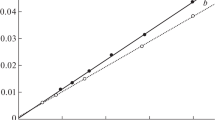Summary
The solubility parameter concept is briefly discussed. It is then used to explain some of the current features of liquid partition and adsorption chromatography. Various phase systems are discussed on the basis of three characteristics:retention, selectivity (the general separation power of a system) andspecificity (increased separation power towards certain pairs of solutes). The emergence of two essentially different techniques, the ‘normal phase’ and ‘reversed phase’ modes, will appear as a logical consequence of simplified theory. It also becomes obvious why ‘reversed phase’ applications are so much more numerous. Some suggestions are given for the development of new stationary phases and the improvement of existing ones. The usefulness of the solubility parameter concept to predict the solvent strength of mixed eluents in reversed phase liquid chromatography (RPLC) is demonstrated. Some practical rules for the selection and operation of stationary and mobile phase systems are formulated.
Zusammenfassung
Das Konzept des Löslichkeitsparameters wird kurz diskutiert. Danach wird es benutzt, um einige Erscheinungen der Flüssig/Flüssig-Verteilungs-(LLC) und Adsorptions-Chromatographie (LSC) zu erklären. Es werden unterschiedliche Phasensysteme bezüglich dreier charakteristischer Erscheinungen besprochen:Retention, Selektivität (erhöhte Trennkraft eines Systems) undSpezifität (erhöhte Trennkraft für bestimmte Substanzpaare). Die Erscheinung zweier wesentlich unterschiedlicher Techniken, der Normalphasen- und der Umkehrphasen-Technik, ergibt sich als logische Konsequenz der vereinfachten Theorie. Es wird auch klar, warum die Reversed Phase. Anwendungen sehr viel zahlreicher als die übrigen sind. Es werden einige Anregungen zur Entwicklung neuer stationärer Phasen und der Verbesserung der bereits bestehenden gegeben. Es wird dargestellt, wie nützlich das Löslichkeitsparameter-Konzept zur Vorhersage der Lösemittelstärke von Lösemittelgemischen in der Umkehrphasen-Chromatographie ist. Zum Schluß werden einige praktische Regeln zur Auswahl und dem Betrieb von stationären und mobilen Phasensystemen formuliert.
Similar content being viewed by others
Literatur
L. R. Snyder, J. Chromatogr.92, 223 (1974).
L. R. Snyder, J. Chrom. Sci.16, 223 (1978).
R. McCormick, P. J. Schoenmakers, B. L. Karger, IVth International Symposium on Column Liquid Chromatography, Boston, 1979.
C. Horváth, W. Melander, I. Molnár, Anal. Chem.49, 142 129 (1976).
C. Horváth, W. Melander, I. Monár, Anal. Chem.49, 142 (1977).
R. A. Keller, B. L. Karger, L. R. Snyder, in: “Gas Chromatography 1970,”R. Stock (Ed.), Institute of Petroleum, London 1971: p. 125.
B. L. Karger C. Eon, L. R. Snyder, J. Chromatogr.125, 71 (1976).
B. L. Karger, L. R. Snyder, C. Eon, Anal. Chem.50, 2126 (1978).
R. Tijssen, H. A. H. Billiet, P. J. Schoenmakers, J. Chromatogr.122, 185 (1976).
J. H. Hildebrand, J. M. Prausnitz, R. L. Scott, “Regular and Related Solutions”, Van Nostrand Reinhold, New York, 1970.
H. G. Harris, J. M. Prausnitz, J. Chrom. Sci.7, 685, (1969).
P. Alessi, I. Kikic, G. Torriano, J. Chromatogr.106, 17 (1975).
A. F. M. Barton, Chem. Rev.75, 731 (1975).
P. J. Schoenmakers, H. A. H. Billiet, R. Tijssen, L. de Galan, J. Chromatogr.149, 519 (1978).
P. J. Schoenmakers, H. A. H. Billiet, L. de Galan, J. Chromatogr.185, 179 (1979).
H. Colin, C. Eon, G. Guiochon, J. Chromatogr.119, 41 (1976); ibid.J. Chromatogr.122, 223 (1976).
H. Colin, G. Guiochon, J. Chromatogr.137, 19 (1976).
K. K. Unger, P. Roumeliotis, H. Mueller, G. Goetz, J. Chromatogr.202, 3 (1980).
E. Smolková, J. Zima, F. Dousek, J. Jansta, Z. Plzák, J. Chromatogr.196, 61 (1980).
A. V. Kiselev, Discuss. Faraday Soc.40, 228 (1964).
G. E. Berendsen, K. A. Pikaart, L. de Galan, C. Oliemann, Anal. Chem.52, 1990 (1980).
P. J. Schoenmakers, H. A. H. Billiet, L. de Galan, J. Chromatogr.218, 261 (1981).
C. Hansen, A. Beerbower, in: “Kirk-Othmer encyclopedia of chemical technology”, 2nd edition, suppl. vol., New York, 1971, p. 889.
J. D. Crowley, G. S. Teague, J. W. Lowe jr., J. Paint Technol.38 (496), 269 (1966);39 (504), 19 (1967).
E. B. Bagley, T. P. Nelson, J. M. Scigliano, J. Paint Technol.43 (555), 35 (1971).
E. B. Bagley, T. P. Nelson, J. W. Barlow, S.-A. Chen, I. & E. C. Fund.9, 93 (1970).
E. B. Bagley, T. P. Nelson, S.-A. Chen, J. W. Barlow, I. & E. C. Fund.10, 27 (1971).
I. A. Wiehe, E. B. Bagley, A.I.Ch. E. Journ.13, 836 (1976).
F. London, Z. Physik. Chem.B11, 222 (1930).
F. London, Trans. Faraday Soc.33, 8 (1937).
C. J. F. Böttcher, “Theory of electric polarization”, Elsevier, Amsterdam, 1952 (1975).
H. Colin, N. Ward, G. Guiochon, J. Chromatogr.149, 169 (1978).
P. J. Schoenmakers, H. A. H. Billiet, L. de Galan, J. Chromatogr.205, 13 (1981).
H. A. H. Billiet, P. S. Schoenmakers, L. de Galan, J. Chromatogr.218, 443 (1981).
Author information
Authors and Affiliations
Rights and permissions
About this article
Cite this article
Schoenmakers, P.J., Billiet, H.A.H. & de Galan, L. Die Löslichkeitsparameter als Werkzeug zum Verständnis der Flüssigkeitschromatographie. Chromatographia 15, 387–398 (1982). https://doi.org/10.1007/BF02259227
Received:
Accepted:
Issue Date:
DOI: https://doi.org/10.1007/BF02259227



